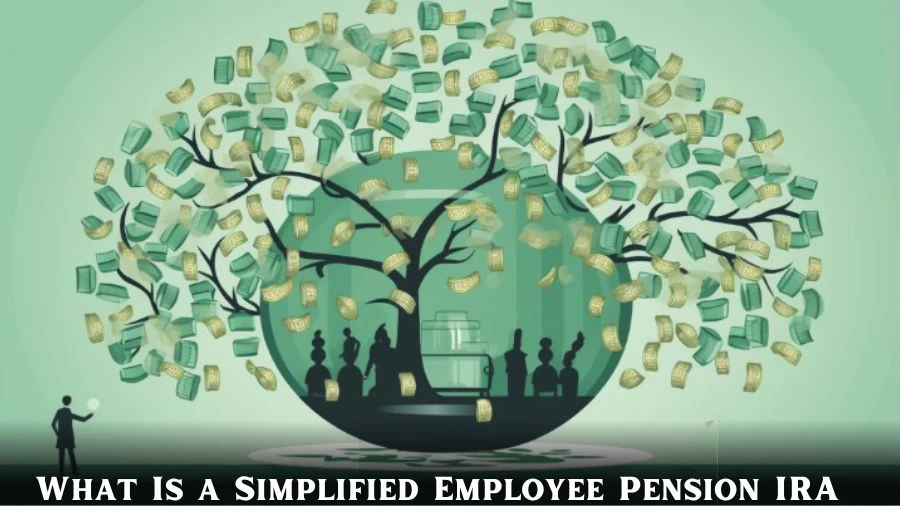
What is a Simplified Employee Pension IRA? How Much Can You Contribute to a SEP IRA?
A SEP IRA is a way for employers and self-employed individuals to help employees save for retirement by putting money into their retirement accounts, which employees can access when they retire, and it also provides some tax advantages.
by Sai V
Published Aug 31, 2023 | Updated Aug 31, 2023 | 📖 11 min read
On This Page
- What is a Simplified Employee Pension IRA?
- Simplified Employee Pension Plan (SEP)
- How SEP IRAs Work?
- How Much Can You Contribute to a SEP IRA?
- SEP IRA Contribution Limits
- How to Set Up a SEP IRA?
- What are the Advantages and Disadvantages of utilizing a SEP IRA?
- What Are the Guidelines for SEP IRA?
- Who Has the Eligibility to Make Contributions to a SEP IRA?
What is a Simplified Employee Pension IRA?
A Simplified Employee Pension (SEP) is a type of individual retirement account (IRA) that can be established by both employers and self-employed individuals. This retirement plan allows employers to contribute to the SEP IRAs of eligible employees while benefiting from a tax deduction for these contributions. These contributions are made at the employer's discretion, providing them with flexibility in managing retirement savings for their workforce.
Notably, the contributions made by the employer are immediately vested, meaning that employees gain full ownership of these funds from the moment they are contributed. SEP IRAs stand as a unique hybrid between traditional IRAs and 401(k) plans, boasting higher annual contribution limits compared to standard IRAs and sharing similarities with 401(k) plans by permitting employer contributions that become immediately vested. This financial instrument provides a versatile and tax-efficient retirement savings option, offering benefits to both employers and employees in building secure financial futures.
Simplified Employee Pension Plan (SEP)
The Simplified Employee Pension Plan, often referred to as SEP, presents a valuable avenue for employers to secure retirement savings for both themselves and their employees. By allowing employers to contribute a portion of employees' pay into retirement accounts, SEP plans offer a convenient and cost-effective alternative to traditional retirement plans. With contributions limited to 25% of each employee's pay, SEP plans are a flexible option, suitable for businesses of any size.
Unlike conventional retirement plans, SEPs have lower start-up and operational costs, making them an attractive choice, particularly for businesses with fluctuating financial cycles. These plans can adapt to varying economic conditions, allowing larger contributions during prosperous periods and adjustments during lean times. SEP's simplicity extends to its eligibility requirements and contribution process, making it accessible to a broad range of businesses.
Participation in a SEP plan requires eligible employees to meet specific criteria, including reaching the age of 21, having a work history with the employer, and meeting minimum compensation thresholds. The SEP plan offers the advantage of employer-only contributions, which aids in creating a consistent retirement fund for employees.
Contributions to SEP-IRAs are vested entirely for employees, ensuring ownership of the funds. SEP plans are recognized for their straightforward setup, affordable administration, and adaptable contribution limits, all of which combine to offer an accessible and appealing retirement solution for businesses seeking to secure the financial future of both employers and employees alike.
How SEP IRAs Work?
SEP IRAs, or Simplified Employee Pension Individual Retirement Accounts, offer business owners and employees a straightforward and adaptable way to save for retirement. With reduced administrative costs and eligibility criteria, SEP IRAs provide an avenue for higher contributions, granting individuals greater control over investment decisions within a tax-advantaged framework.
Contributions and Eligibility:
- SEP IRAs are retirement savings accounts for business owners and employees.
- Contributors must be at least 21 years old and have a minimum of three years of employment.
- Employees need to meet a compensation minimum, like $650 in 2022 and $750 in 2023, to qualify for SEP IRA contributions.
Tax Treatment and Investment Options:
- SEP IRAs share tax similarities with traditional IRAs.
- Employers get a tax deduction for their contributions to employees' SEP IRA accounts.
- Investment options are akin to those in traditional IRAs.
- Transfer and rollover rules match those of traditional IRAs, offering flexibility.
Flexibility and Employer's Role:
- SEP IRAs allow contribution flexibility, permitting employers to skip contributions during lean business years.
- Employers aren't responsible for employee investment choices.
- An IRA trustee selects eligible investments, while individual employees make investment decisions based on their preferences.
Administrative Tasks:
- IRA trustees handle administrative tasks like depositing contributions, sending annual statements, and managing IRS documents.
Benefits for Small Organizations:
- SEP IRAs are favored by small businesses due to low costs and tailored eligibility criteria.
- Eligibility rules align with stable, long-term employment relationships.
How Much Can You Contribute to a SEP IRA?
Contributions to a Simplified Employee Pension (SEP) IRA are subject to specific IRS rules and limitations. These guidelines outline the maximum allowable contributions that can be made to a SEP IRA for yourself or your employees.
Percentage of Compensation or Fixed Dollar Limit:
- The contributions that you, as the employer, make to each employee's SEP IRA in a given year must not exceed the lesser of either 25% of the employee's compensation or a specified dollar limit.
- The dollar limit for 2023 is $66,000. However, it's important to note that this dollar limit is subject to annual adjustments based on the cost of living.
Applicability Across Defined Contribution Plans:
- The contribution limits mentioned above are not exclusive to SEP IRAs. They apply to all defined contribution plans, which encompass SEP IRAs as well.
Maximum Considered Compensation:
- When calculating the contributions, only a portion of an employee's compensation is taken into account.
- For the year 2023, the maximum compensation that can be considered for calculating contributions is $330,000. This threshold is also subject to annual adjustments based on changes in the cost of living.
Special Calculation for Self-Employed Individuals:
- If you are self-employed and contributing to your own SEP IRA, you'll need to follow a distinct calculation method.
- This calculation ensures that your contributions align with the contribution limits while accounting for your self-employed status.
Cash Contributions Only:
- Contributions to SEP IRAs must be made in cash. It is not permissible to contribute property as part of these contributions.
SEP IRA Contribution Limits
SEP IRA Contribution Limits:
The SEP IRA contribution limits establish that employers can contribute up to 25% of an employee's total compensation or a maximum of $61,000 for 2022 ($66,000 for 2023). Self-employed individuals have a 20% limit on net income, with thresholds of $305,000 for 2022 and $330,000 for 2023. Employees, however, can contribute up to $6,500 ($7,500 if 50 or older) to their SEP-IRA or other IRAs in 2023, following IRS regulations.
Employer Contribution Limits:
- Employers can contribute up to 25% of an employee's total compensation or a maximum of $61,000 for the 2022 tax year or $66,000 for the 2023 tax year, whichever is lower.
- Self-employed individuals have a contribution limit of 20% of their net income.
- Net compensation for self-employed individuals is calculated as the net profit from IRS Schedule C, reduced by the deductible self-employment tax.
- The eligible compensation limit, adjusted for inflation by the IRS, is set at $305,000 for 2022 or $330,000 for 2023.
- Contributions are tax-deductible and are not obligatory every year.
- Contributions must be uniform for both employers and employees, within the specified limit.
- The SECURE 2.0 Act permits employers with SEP-IRAs to introduce Roth contributions. However, Vanguard currently does not offer the SEP Roth option.
Employee Contribution Limits:
- Employees cannot directly defer their salary into a SEP-IRA, unlike some other retirement plans.
- Employees might have the option to make traditional IRA contributions to their SEP-IRA, with a maximum limit of $6,500 for the 2023 tax year ($7,500 for employees aged 50 or older).
- This contribution cap encompasses the entire allowable contributions that employees can make across all their IRAs, including SEP, traditional, or Roth IRAs, within a single tax year.
How to Set Up a SEP IRA?
Establishing a SEP IRA involves a three-step process to provide retirement benefits to eligible employees. The initial step entails formalizing a written agreement outlining the benefit structure, followed by the dissemination of essential plan information to employees. Subsequently, individual IRA accounts are established for each employee, alongside dedicated SEP-IRAs to receive employer contributions.
These SEP-IRAs are facilitated by qualified financial institutions and require employees to make investment decisions. This retirement arrangement allows tax-deductible employer contributions and offers flexibility in setup timing, extending to the due date of the business tax return for the intended year.
Formulate a Written Agreement:
Initiate the process by crafting a written agreement outlining your commitment to offering SEP benefits to all eligible employees. This agreement serves as the core framework of the SEP plan, detailing the terms and conditions under which the benefits will be granted.
Disseminate Employee Information:
It is essential to furnish eligible employees with specific details about the SEP plan. This encompasses a comprehensive understanding of the plan's mechanics, the anticipated benefits they'll receive, and their responsibilities and entitlements as beneficiaries of the plan.
Establish an Individual IRA for Each Employee:
As part of the SEP setup, you'll need to create an Individual Retirement Account (IRA) for every eligible employee. These IRAs act as the designated containers to receive contributions from the SEP plan. The process involves partnering with recognized financial institutions, such as banks or insurance companies.
Timing the SEP Formation:
The setup window for a SEP plan is flexible. You're permitted to establish a SEP for a specific tax year until the due date of your business income tax return for that year, inclusive of any extensions. This accommodates planning considerations aligned with your financial circumstances for the given year.
What are the Advantages and Disadvantages of utilizing a SEP IRA?
A Simplified Employee Pension Individual Retirement Account (SEP-IRA) offers benefits like easy setup, low administrative costs, and flexible contributions. However, it's limited to employer contributions, has contribution caps, and lacks participant loans. In-service withdrawals are possible but come with tax implications. Deciding on a SEP-IRA requires considering its pros and cons in line with one's financial goals.
Advantages of SEP-IRA:
- Establishing and maintaining a SEP-IRA is straightforward, making it accessible for employers.
- SEP-IRAs generally have lower administrative expenses compared to some other retirement plans, benefiting both employers and employees.
- SEP-IRAs offer flexible annual contribution options, which can be advantageous when managing cash flow is a concern.
- Employers must contribute equally for all eligible employees, fostering a sense of fairness and inclusion.
Disadvantages of SEP-IRA:
- SEP-IRAs rely solely on employer contributions; employees cannot contribute directly from their wages.
- There are limitations on the total contributions allowed per employee's SEP-IRA, potentially limiting the potential retirement savings.
- While usually having fewer filing obligations, employers might still have some reporting requirements for SEP-IRAs.
- Unlike certain other retirement plans, SEP-IRAs do not permit participants to borrow against their account balances.
- Although in-service withdrawals are allowed, they come with tax implications, including income tax and a 10% additional tax if the participant is under 59 ½.
What Are the Guidelines for SEP IRA?
Simplified Employee Pension Individual Retirement Accounts (SEP IRAs) offer a valuable retirement savings option for certain businesses and their employees. These accounts come with specific guidelines that govern their establishment, contribution limits, participant eligibility, and withdrawal conditions.
Eligible Businesses and Participants:
SEP IRAs were designed to extend retirement benefits to businesses lacking employer-sponsored plans. Sole proprietors, partnerships, and corporations are eligible to establish SEP IRAs. However, other business types are excluded from this option.
Income Limitation:
For those considering contributions to a SEP IRA, an income limitation comes into play. The eligible compensation limit, as of 2023, stands at $330,000. This serves as the cap for annual contributions to a SEP IRA, ensuring that contributions remain within the defined income range.
Borrowing Restrictions:
Unlike some retirement plans that allow participants to borrow against their vested balances, SEP IRAs do not offer this feature. Regardless of whether an individual is the business owner or an employee, borrowing against the SEP IRA balance is not permitted.
Employee Exclusion:
Employers have the flexibility to exclude specific employees from participating in the SEP IRA, even if they meet eligibility criteria. For instance, employees covered by a union collective bargaining agreement related to retirement benefits can be exempted. Nonresident employees who do not receive U.S. wages or service compensation from the employer are also subject to exclusion.
Withdrawals and Contributions:
SEP IRAs permit contributions and earnings to accumulate within the account over time. While withdrawals can be made at any point, they are subject to standard limitations applied to traditional IRAs. Withdrawals are taxed in the year they are received. However, individuals withdrawing funds before reaching the age of 59½ are typically subject to a 10% additional tax, unless they qualify for specific exceptions.
Who Has the Eligibility to Make Contributions to a SEP IRA?
Eligibility for making contributions to a SEP IRA (Simplified Employee Pension Individual Retirement Account) is based on specific criteria. To be eligible, an individual must be 21 years of age or older and must have worked for the company for any period of time during at least 3 out of the last 5 years, with full-time employment status (not as a contractor).
Additionally, the employee must earn at least the minimum annual compensation established by the SEP IRA-sponsoring employer, which stands at $750 for the year 2023. While these criteria determine who is considered eligible, employers have the option to make contributions to SEP IRA accounts of employees who do not meet all of these requirements, although such contributions are not obligatory.
Furthermore, it's noteworthy that SEP IRA contributions are required to follow a consistent percentage of income basis for all eligible employees, including the business owner. However, there is no mandatory annual contribution from the business owner to their own SEP IRA, offering flexibility in this regard.
Some individuals, such as those covered by a union collective bargaining agreement for retirement benefits, and non-U.S. residents who do not receive U.S. wages, can be excluded from participation in the company's SEP IRA plan. As regulations and guidelines can evolve, individuals are advised to verify the most current eligibility rules through reliable sources or consult financial professionals.
What is a Simplified Employee Pension IRA - FAQs
1. What is a SEP IRA?
A Simplified Employee Pension Individual Retirement Account is a retirement plan where employers contribute to employees' IRAs, offering tax benefits.
2. Who can contribute to a SEP IRA?
Employers can contribute on behalf of eligible employees, meeting age, work history, and compensation criteria.
3. What are the advantages of a SEP IRA?
SEP IRAs offer easy setup, lower administrative costs, and flexibility in employer contributions.
4. What are the contribution limits for SEP IRAs?
Employers can contribute up to 25% of employee compensation or a maximum of $66,000 in 2023.
5. Can employees contribute to a SEP IRA?
Employees cannot directly contribute, but they might make traditional IRA contributions separately.




